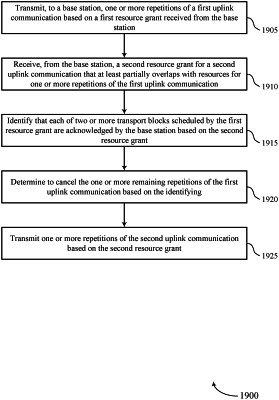| CPC H04W 72/23 (2023.01) [H04L 1/189 (2013.01); H04L 1/1896 (2013.01); H04W 72/1268 (2013.01)] | 44 Claims |

|
1. A method for wireless communication at a user equipment (UE), comprising:
receiving, from a network device, a first resource grant that schedules a first set of two or more transport blocks for a first uplink communication, the first resource grant indicating a first set of hybrid automatic repeat request (HARQ) process identifiers (IDs) associated with the first set of transport blocks, and the first resource grant indicating a respective new data indicator for each HARQ process ID of the first set of HARQ process IDs;
transmitting, to the network device, one or more repetitions of a first uplink communication comprising the first set of two or more transport blocks in accordance with the first resource grant;
receiving, from the network device, a second resource grant that schedules a second set of one or more transport blocks for a second uplink communication that at least partially overlaps with resources for one or more additional repetitions of the first uplink communication comprising the first set of two or more transport blocks; and
selectively canceling one or more remaining repetitions of the first uplink communication based at least in part on the second resource grant providing an implicit acknowledgment of successful receipt of the set of two or more transport blocks of the first uplink communication, wherein the implicit acknowledgment is based at least in part on the second resource grant indicating a second set of HARQ process IDs, wherein each HARQ process ID of the second set of HARQ process IDs either:
is not included in the first set of HARQ process IDs, or
is included in the first set of HARQ process IDs and has a different new data indicator than the respective new data indicator.
|